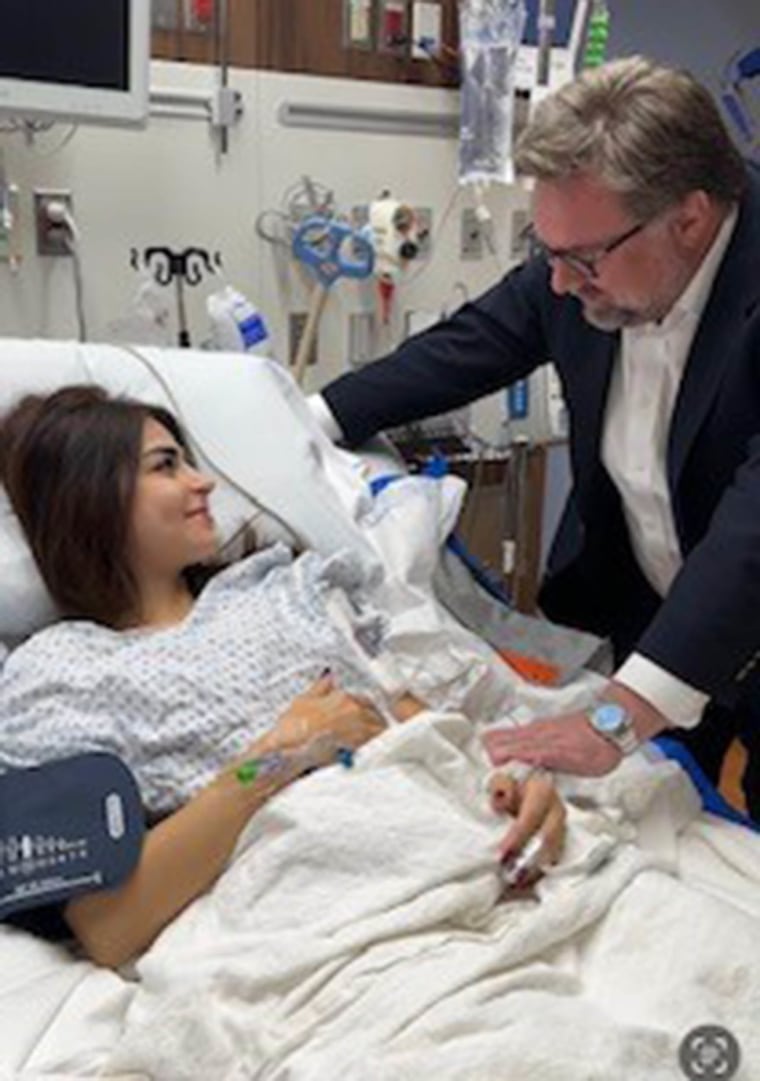Safa Srour, 33, a Dubai-based beauty and fashion influencer, was jet-setting between international fashion weeks when she noticed sudden vision changes. Out of nowhere, she saw a zig-zag line appear in her vision.
"That was really scary because I never had it before in my life," Srour tells TODAY.com. She went to the doctor, who told her she would need bloodwork and an MRI, but she was about to leave for another fashion week trip, so she put it on hold.
Six weeks later, in October 2023, she came home and immediately experienced the same symptoms. This time, however, she also had numbness on the right side of her body. Remembering what her doctor told her previously, she rushed to get an MRI.
"I leave the hospital, and they call me to tell me to come right back," she recalls. "I knew (it was) nothing good."
Srour went back in. While doctors eventually determined her symptoms were due to a migraine aura, the MRI had picked up something else: a brain aneurysm.
What is a brain aneurysm?
A brain aneurysm occurs when part of a blood vessel becomes weak, Dr. J Mocco, endovascular neurosurgeon and director of the Cerebrovascular Center at Mount Sinai, tells TODAY.com.
When that happens, "a portion of the wall that no longer has integrity starts to balloon out like bubble gum," Mocco explains. On its own, this situation isn't necessarily dangerous, and aneurysms don't tend to cause symptoms — until they burst.

"If that balloon pops and high-pressure blood from the artery starts shooting into the brain, that can be extremely dangerous and very scary," Mocco says.
A ruptured brain aneurysm typically causes a sudden and severe headache along with other symptoms — like vision changes, nausea or vomiting and seizures — and is a life-threatening medical emergency. If doctors catch a brain aneurysm before it's ruptured, they may decide to treat it preemptively. (Srour’s aneurysm had not ruptured, and her symptoms were due to a migraine attack.)
Somewhere between 2% and 4% of the U.S. population "harbors some brain aneurysm," Mocco says, meaning that millions of people are likely living with a brain aneurysm and may not know.
Doctors most frequently find brain aneurysms in people who are in their late 50s, he explains, so it's "a little bit unusual" to find a brain aneurysm in someone as young as Srour. But it does happen from time to time, Mocco says. "In fact, I've treated children as young as 4 and 5 years old with brain aneurysms, although that's very uncommon," he adds.
Brain aneurysm treatment
Not all brain aneurysms need treatment, Mocco says, particularly if they are small and unlikely to rupture.
However, that was not the case for Srour.
Her aneurysm was particularly large and had an odd, irregular shape known as a "daughter sac," meaning it had a higher chance of bleeding, Mocco explains. Srour's father also passed away in 2018 during surgery to treat a ruptured aneurysm, further adding to her risk — and the emotional weight of her treatment decision.
"I was terrified," she says. "Nobody could (tell) me exactly what was going to happen to me, except crazy scary scenarios. That was the only thing everyone agreed on."
Srour and her family worked with Mocco to decide the best course of treatment.
One option was a craniotomy, which would require opening up Srour's head, clipping the brain aneurysm off and then replacing a piece of her skull, Mocco says. But they ultimately opted for a less invasive route: stent-assisted coiling, which Srour underwent in New York City just a month after her MRI.

During this procedure, Mocco starts by snaking a small catheter up from the leg all the way up to the brain. From there, "we fill the aneurysm up with small platinum coils," Mocco explains. "Then we use a stent to cover the opening of the aneurysm and to hold all the coils (inside)."
By filling the aneurysm up, it's cut off from the blood supply. And the "body will naturally heal over the metal and close the hole," Mocco says. The platinum coils will stay in place permanently, and the blood vessel tissue surrounding it will "all contract and scar down," he says.
Recovery and looking back
Srour's recovery from the stent-assisted coiling procedure was minimal, Mocco says, and she was able to leave the hospital just 24 hours later. Srour will have to take aspirin and a blood-thinning medication for about three months. "Then she'll just be on the aspirin for a while, and eventually she'll be able to come off the aspirin, as well," Mocco says.
Srour is not typically one to show emotion, she says, and she admits that dealing with the fear and anxiety brought on by this health scare was challenging. "I also was very worried about my family," she says. "From diagnosis to treatment, I did not even think of myself. ... I wanted to be strong for them."
She's also grateful for the support of Mocco and his team, who told her they would be "lifelong friends" as she navigates life after her aneurysm. Now that Srour has had one aneurysm, she has "a little more risk" than the general population at her age for developing another one, Mocco says.
"Every so often, we're going to check in, and we'll do an MRI to make sure that there's no trouble brewing," he explains. "But the overwhelming likelihood is that this will never bother her again, and she's going to go back to her life and never have to worry about it."
Looking back, Srour wishes she hadn't waited until the last minute to get that MRI. But, now that she's healed, she's taking the opportunity to spread awareness about aneurysms and to focus her content on "topics that can actually help people and make a difference," she says.
As challenging as the experience has been, Srour is also grateful for it because it's made her so thankful for every single opportunity she gets. And it's made her "much, much stronger," Srour says.